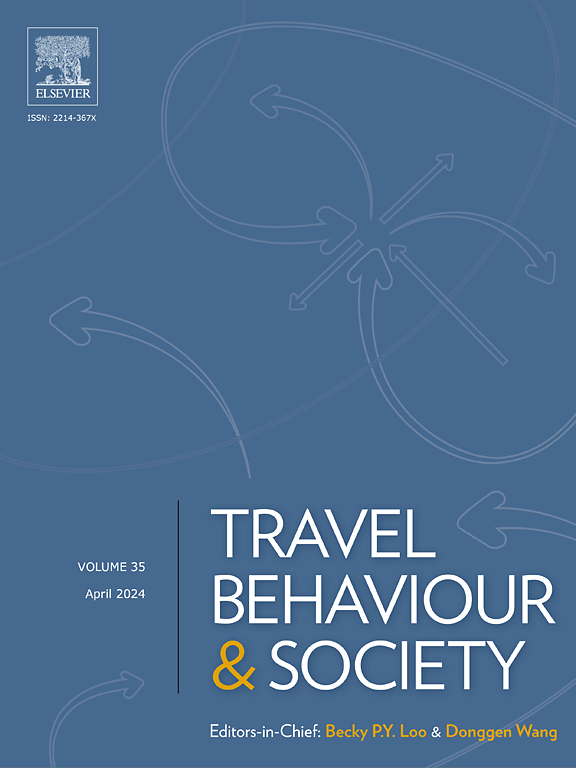车辆自动化、车载环境和车内时间使用:陈述选择实验的结果
IF 5.7
2区 工程技术
Q1 TRANSPORTATION
引用次数: 0
摘要
本研究基于对696名美国国家公园游客进行的陈述选择实验,考察了车辆自动化和车载活动对旅行模式偏好的影响。利用多项和混合logit模型分析了人们对人类驾驶汽车(HV)、自动驾驶汽车(AV)和带有工作和休闲内饰的自动驾驶汽车(AV- wl)的偏好,并计算了出行时间(VOTT)的相关值。HV、AV和AV- wl的估计VOTT值分别为每小时34.80美元、31.10美元和29.90美元。从HV到AV以及从AV到AV- wl的VOTT减少表明,车辆自动化和车载环境对旅行者的时间感知价值有切实的金钱影响。虽然车内活动对HV的VOTT没有显著影响,但娱乐活动对AV和AV- wl的VOTT有可测量的影响。尽管研究结果表明,车内活动和车载环境对自动驾驶汽车采用和相关VOTT的影响不如预期的那么大,但他们强调,车辆自动化、内部设计、车内活动倾向及其实用性是影响自动驾驶时代模式选择决策的关键因素。此外,这些发现表明,除非设计出适合工作和休闲活动的车辆内饰,否则由于自动化而改变活动旅行模式的可能性不大。因此,从使用时间的角度来看,汽车自动化可能会加剧汽车尺寸变大的问题,增加能源消耗和空间需求,因为具有良好和更宽敞内饰的自动驾驶汽车变得越来越受欢迎。本文章由计算机程序翻译,如有差异,请以英文原文为准。
Vehicle automation, onboard environment, and in-vehicle time use: Findings from a stated choice experiment
This study examines the impact of vehicle automation and onboard activities on travel mode preferences based on a stated choice experiment conducted among 696 visitors to US national parks. Several multinomial and mixed logit models were estimated to analyze preferences for human-driven vehicles (HV), autonomous vehicles (AV), and AVs with work and leisure interiors (AV-WL), and to calculate the associated value of travel time (VOTT). The estimated VOTT values for HV, AV, and AV-WL were $34.80, $31.10, and $29.90 per hour, respectively. The reduction in VOTT from HV to AV and further from AV to AV-WL indicates that vehicle automation and onboard environments have a tangible monetary impact on travelers’ perceived value of time. While in-vehicle activities did not significantly contribute to VOTT for HV, entertainment activities had a measurable impact on VOTT for AV and AV-WL. Although the results indicate that the influence of in-vehicle activities and onboard environments on AV adoption and associated VOTT is less substantial than expected, they highlight that vehicle automation, interior designs, and the propensity for in-vehicle activities and their usefulness are critical factors influencing mode choice decisions in the AV era. Furthermore, these findings suggest that a shift in activity travel patterns due to automation is unlikely unless suitable vehicle interiors are designed to support work and leisure activities. Thus, from a time-use perspective, vehicle automation may exacerbate the issue of larger car sizes, increasing energy consumption and space requirements as automated vehicles with favorable and more spacious interiors become more desirable.
求助全文
通过发布文献求助,成功后即可免费获取论文全文。
去求助
来源期刊

Travel Behaviour and Society
TRANSPORTATION-
CiteScore
9.80
自引率
7.70%
发文量
109
期刊介绍:
Travel Behaviour and Society is an interdisciplinary journal publishing high-quality original papers which report leading edge research in theories, methodologies and applications concerning transportation issues and challenges which involve the social and spatial dimensions. In particular, it provides a discussion forum for major research in travel behaviour, transportation infrastructure, transportation and environmental issues, mobility and social sustainability, transportation geographic information systems (TGIS), transportation and quality of life, transportation data collection and analysis, etc.
 求助内容:
求助内容: 应助结果提醒方式:
应助结果提醒方式:


